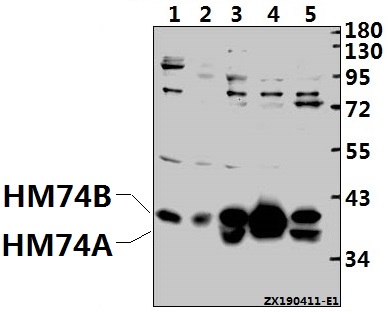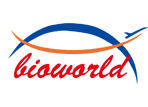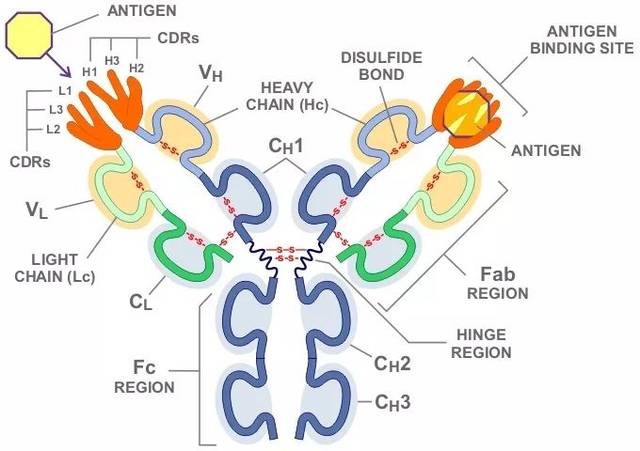Product Name :
HM74 (T327) polyclonal antibody Background :
HM74, also known as PUMAG or Puma-g, is a member of the G protein coupled receptor (GPCR) superfamily. In humans, HM74 is encoded by two different genes (GPR109A and GPR109B) that produce proteins, namely HM74A and HM74 (or HM74B), which are 96% homologous. In mice and rats, only one gene encodes the HM74 protein (Gpr109a). HM74 is a G(i) protein-coupled receptor that mediates the metabolic effects of nicotinic acid. Localizing to the cell membrane, HM74 is highly expressed in adipocytes, immune cells and spleen. Like all members of the GPCR superfamily, HM74 contains seven transmembrane domains. HM74 lacks the N-linked glycosylation sites near the N-terminus that are present in other GPCR family members. Product :
Rabbit IgG, 1mg/ml in PBS with 0.02% sodium azide, 50% glycerol, pH7.2 Storage&Stability :
Store at 4°C short term. Aliquot and store at -20°C long term. Avoid freeze-thaw cycles. Specificity :
HM74 (T327) polyclonal antibody detects endogenous levels of HM74B protein. This antibody also recognizes HM74A protein. Immunogen :
Synthetic peptide, corresponding to amino acids 300-350 of Human HM74. Conjugate :
Unconjugated Modification :
Unmodification
HM74 (T327) polyclonal antibody Background :
HM74, also known as PUMAG or Puma-g, is a member of the G protein coupled receptor (GPCR) superfamily. In humans, HM74 is encoded by two different genes (GPR109A and GPR109B) that produce proteins, namely HM74A and HM74 (or HM74B), which are 96% homologous. In mice and rats, only one gene encodes the HM74 protein (Gpr109a). HM74 is a G(i) protein-coupled receptor that mediates the metabolic effects of nicotinic acid. Localizing to the cell membrane, HM74 is highly expressed in adipocytes, immune cells and spleen. Like all members of the GPCR superfamily, HM74 contains seven transmembrane domains. HM74 lacks the N-linked glycosylation sites near the N-terminus that are present in other GPCR family members. Product :
Rabbit IgG, 1mg/ml in PBS with 0.02% sodium azide, 50% glycerol, pH7.2 Storage&Stability :
Store at 4°C short term. Aliquot and store at -20°C long term. Avoid freeze-thaw cycles. Specificity :
HM74 (T327) polyclonal antibody detects endogenous levels of HM74B protein. This antibody also recognizes HM74A protein. Immunogen :
Synthetic peptide, corresponding to amino acids 300-350 of Human HM74. Conjugate :
Unconjugated Modification :
Unmodification
-
 Western blot (WB) analysis of GPR109B pAb at 1:500 dilution Lane1:PMVEC whole cell lysate(40ug) Lane2:SP2/0 whole cell lysate(40ug) Lane3:A549 whole cell lysate(40ug) Lane4:Myla2059 whole cell lysate(40ug) Lane5:MCF-7 whole cell lysate(40ug)
Western blot (WB) analysis of GPR109B pAb at 1:500 dilution Lane1:PMVEC whole cell lysate(40ug) Lane2:SP2/0 whole cell lysate(40ug) Lane3:A549 whole cell lysate(40ug) Lane4:Myla2059 whole cell lysate(40ug) Lane5:MCF-7 whole cell lysate(40ug)
Distinct kinetic and spatial patterns of PKC- and EGFR-dependent activation of extracellular signal-regulated kinases 1 and 2 by humane nicotinic acid receptor GPR109A
PMCID: Pubmed No.:21768093
Upregulation of GPR109A in Parkinson's Disease
PMCID: Pubmed No.:25329911
Upregulation of GPR109A in Parkinson's Disease
PMCID: Pubmed No.:25329911
Butyrate ameliorates caerulein‐induced acute pancreatitis and associated intestinal injury by tissue‐specific mechanisms
PMCID: Pubmed No.:31347703
Bioworld Biotech only provide peptides for our antibodies and do not provide additional peptide customization services.
Price/Size :
USD 368/1mg/vial
Tips:
For phospho antibody, we provide phospho peptide(0.5mg) and non-phospho peptide(0.5mg).Describe :
Blocking peptides are peptides that bind specifically to the target antibody and block antibody binding. These peptide usually contains the epitope recognized by the antibody. Antibodies bound to the blocking peptide no longer bind to the epitope on the target protein. This mechanism is useful when non-specific binding is an issue, for example, in Western blotting (WB) and Immunohistochemistry (IHC). By comparing the staining from the blocked antibody versus the antibody alone, one can see which staining is specific; Specific binding will be absent from the western blot or IHC performed with the neutralized antibody.Formula:
Synthetic peptide was lyophilized with 100% acetonitrile and is supplied as a powder. Reconstitute with 0.1 ml DI water for a final concentration of 10 mg/ml.The purity is >90%,tested by HPLC and MS.
Storage:
The freeze-dried powder is more stable. For short time at 2-8°C. For long term storage store at -20°C.
Note :
This product is for research use only (RUO only). Not for use in diagnostic or therapeutic procedures.
 HM74 (T327) polyclonal antibody
HM74 (T327) polyclonal antibody  Datasheet
Datasheet COA
COA MSDS
MSDS SHIP
SHIP